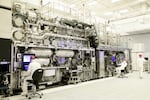
In this provided photo, Intel's High Numerical Aperture Extreme Ultraviolet lithography tool sits in a clean room at Intel Corporation's Fab D1X in Hillsboro, Ore., in April 2024. The 165-ton High NA EUV tool was built by ASML and is the first commercial lithography system of its kind in the world. The machine will allow Intel Foundry to continue its effort to create powerful chips with ever-smaller transistors.
Courtesy of Intel Corporation
Intel is in the process of implementing a first-of-its kind tool to advance the development of semiconductors, a move that the tech giant is hoping will cement it and Oregon as a hub for cutting-edge chip technology for years to come.
Intel has completed assembly of the massive device — called a high numerical aperture extreme ultraviolet lithography scanner, High NA EUV for short — at its Hillsboro campus, the chipmaker announced Thursday. The Dutch company ASML developed the $350 million machine.
Intel is headquartered in California, but Hillsboro acts as the company’s main research and development site. The computer chip firm is Oregon’s largest private employer with more than 20,000 workers.
In its announcement, Intel said the tool “will be able to deliver never-before-seen precision and scalability in chip manufacturing, enabling the company to develop chips with the most innovative features and capabilities that are essential for driving advancements in [artificial intelligence] and other emerging technologies.”
The health of Intel can act as a bellwether for Oregon’s semiconductor industry. Economists say the industry could add thousands of jobs in the state over the next decade and bring other financial benefits to Oregon, like an increase in tax revenue.
But analysts say Intel has some catching up to do. The company helped develop the last major innovation in tools for chip making, but ultimately decided not to adopt the resource. Meanwhile, other major international chip firms did, and have emerged as leaders in semiconductors for the growing AI field.
A large infusion of federal and state funding has flown to Intel in recent years, however, as government leaders have signed on to the goal of helping Intel regain its top position, including through spending announced last month. Federal policymakers hope the success of companies like Intel will pull overseas semiconductor jobs in manufacturing back to the U.S. Lawmakers in Oregon have approved millions in funding for the company for growing and upgrading facilities in the state.
Intel leaders appear determined not to get left behind again when it comes to the latest and greatest chipmaking technology. The company has committed more than $30 billion to upgrading its Oregon facilities. In the pursuit of faster and more efficient computer chips, the new lithography tool will allow the company to create extremely small lines that act as a guide for the chip’s circuitry.
Mike Wilkerson, partner and senior economist at Portland-based consulting and research firm ECOnorthwest, has been following the state’s semiconductor and high tech industries — often called the “silicon forest” — over the last decade. He said research and use of state-of-the-art technological tools can have an economic impact beyond the walls of a single company.
“When you’re at that cutting edge, you’re refreshing that technology much more frequently, almost continuously,” Wilkerson said. “So you’re continuously engaging the broader economy beyond just the local semiconductor space.”
Wilkerson said staying at the technological forefront means building more facilities, which stimulates the local construction sector. Advanced manufacturing companies also need to hire, train and retain high-skilled workers.
“And certainly from an income perspective as the state, you’re getting higher income individuals, they’re paying larger personal income tax,” Wilkerson said, “and that also generates some more broad-based benefits.”
Overall, state economists say they’re watching the health of the semiconductor industry as they make projections for job growth in Oregon. State Employment Economist Gail Krumenauer said in March the industry employed just over 33,500 Oregonians, and is expected to grow by about 3,000 jobs over the next eight years.
Krumenauer said when the semiconductor industry or any sector creates jobs, the benefits go beyond the individual wage-earner.
“Workers go spend their money in the local community buying groceries or going to Topgolf or things like that,” she said. “And the money that they’re spending doing that supports jobs and other local industries as well.”
